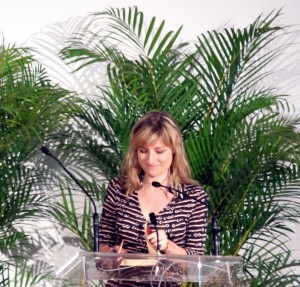The Bollywood showcards exhibit runs until Oct. 2. (Pictures by Mahesh Abeyewardene)
The Institute for Contemporary Culture (ICC) at the Royal Ontario Museum celebrated the Year of India with an exhibition of Bollywood history of Cinema Showcards: Indian Film Art from the 1950s – 1980s. Bollywood Cinema Showcards will be on view in the special exhibition gallery on level three of the Ontario Museum until Sunday, October 2, 2011.
Over 120 works of art are on display including 77 showcards from the private collection of Angela Hartwick and lobby cards and fi lm booklets from the ROM’s permanent collection. The combination of photography and painting of the posters show the unique talents of visual art in South Asia.
Deepali Dewan, Curator South Asian Arts and Culture at Royal Ontario Museum.
“Bollywood Cinema Showcards is a unique opportunity for visitors to see this rare collection of vintage cinematic art, bringing early Bollywood culture and design to life,” said Janet Carding ROM Director and CEO. “I’m delighted that the ROM is contributing in such as significant way to this year-long celebration of India in Canada and the Bollywood experience in Toronto surrounding the International Indian Film Academy Awards.”

Collector Angela Hartwick.
Angela Heartwic, who now lives in Mumbai, received training in orchestral music at a very young age. Since her childhood Angela developed the sense to explore the beauty and history of art. She also had the influence of many Danielle Steel novels. At age 15 she managed to move on her own to Hong Kong sponsored by a Canadian government scholarship and returned with a wealth of knowledge of the Far East.
Then, Angela worked as a nanny in New York for a short period and moved to Paris and became the assistant to a French movie star. Working several years as an actor’s assistant gave her the opportunity to travel to many destinations.
Later, she worked in fashion and film industries with her husband, a talented photographer who is at the beginning of his career. While going through the fi lm posters in 1950s which were in tinted silver gelatin print on textured board with screen printed letters my memories flooded back to the past.
Exhibition showcases Indian works of art spanning from 1950s to 80s.
I remembered watching Mother India with my family in Modern Cinema in Bandarawela, Sri Lanka, which was housed in a massive tent. The main form of local advertising for the film was in big posters fixed onto wooden frames on a vehicle roaming in and out of the city with a loud speaker. Advertising was usually conducted in the middle of the week. When the vehicle stopped, people gathered around the vehicle and small white paper handouts were distributed with the time and the venue of the film screening.
Those were the formative years of cinema advertising before sophisticated technology took over.
Painted posters were used in Sri Lanka and other parts of South Asia for film advertising.
